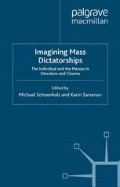Abstract
In 2001, Danish artist Nina Maria Kleivan dressed up her baby daughter in the attire of Hitler, Stalin and other infamous twentieth-century dictators. She photographed the infant, and the result, the photo series Potency went on to receive massive international attention, from within the art world as well as from the mainstream news media. What precisely was it in the unsettling image of a soft-skinned baby with huge eyes dressed up as Pinochet, among other figures, that served to provoke such a strong reaction? It could be argued that Kleivan was exploring some of the deeply rooted, almost automatized, ideas about childhood — and about totalitarian society — that determine modern society. All children are assumed to be born innocent, their tiny beings beyond guilt and culpability. As such they represent the polar opposite of the totalitarian leader. When asked about her photographs, Kleivan stated that everyone begins life the same and with the potential to do good or evil.1 She seems to suggest that the child somehow exists outside of these moral categories.
Access this chapter
Tax calculation will be finalised at checkout
Purchases are for personal use only
Preview
Unable to display preview. Download preview PDF.
Notes
Jenny Hockey and Allison James, Growing Up and Growing Old: Ageing and Dependency in the Life Course (London: Sage, 1993), p. xx.
For a discussion on this, see Jay Winter, Remembering the War: The Great War between Memory and History in the Twentieth Century (New Haven and London: Yale UP, 2006).
Peter Pozefsky in his article ‘Childhood and the Representation of the History of Stalinism in Russian Cinema of the Transition’, Studies in Russian and Soviet Cinema 4(1) (May 2010), pp. 23–44.
Although used by many, Hitler, Stalin and Mao are among those whose propaganda machinery favoured pictures with children. A simple search on the Internet comes up with plenty of illustrative examples. For literature on this, see, for example, Ian Kershaw, The ‘Hitler Myth’: Image and Reality in the Third Reich (Oxford: Oxford UP, 1987), pp. 79
Catriona Kelly, Children’s World: Growing Up in Russia, 1890–1991 (New Haven: Yale UP, 2007), esp. p. 93f.
Italo Calvino, The Path to the Spiders’ Nests (rev. ed.), Archibald Coquhoun (transl.), (New York: The Ecco Press, 2000), p. 184.
See Carolyn Steedman, Strange Dislocations. Childhood and the Idea of Human Interiority, 1780–1930 (Cambridge, MA: Harvard UP, 1995)
Johan Paul Eakin, How Our Lives Become Stories: Making Selves (Ithaca, NY and London: Cornell UP, 1999).
Evelyne Ender, Architexts of Memory: Literature, Science and Autobiography (Ann Arbor: The University of Michigan Press, 2005), p. 3.
Kerwin Lee Klein, ‘On the Emergence of Memory in Historical Discourse’, Representations, No. 69 (Winter 2000), pp. 127–150
Juan Goytisolo, Forbidden Territory and Realms of Strife. The Memoirs of Juan Goytisolo, Peter R. Bush (transl.), (New York: Verso, 2003), p. 28.
Christa Wolf, A Model Childhood, Ursule Molinaro and Hedwig Rappolt (transl.), (London: Virago Press, 2002), pp. 229f.
Slavoj Žižek, Did Somebody Say Totalitarianism? Five Interventions in the (Mis)use of a Notion (London and New York: Verso, 2001), p. 1.
György Dragomán, The White King, Paul Olchváry (transl.), (London: Doubleday, 2008), p. 218.
Herta Müller, ‘A good person is worth as much as a piece of bread’, in Kent Klich, Children of Ceausescu (New York: Umbrage, 2001).
Editor information
Editors and Affiliations
Copyright information
© 2013 Karin Nykvist
About this chapter
Cite this chapter
Nykvist, K. (2013). Through the Eyes of a Child: Childhood and Mass Dictatorship in Modern European Literature. In: Schoenhals, M., Sarsenov, K. (eds) Imagining Mass Dictatorships. Mass Dictatorship in the 20th Century. Palgrave Macmillan, London. https://doi.org/10.1057/9781137330697_6
Download citation
DOI: https://doi.org/10.1057/9781137330697_6
Publisher Name: Palgrave Macmillan, London
Print ISBN: 978-1-349-46118-9
Online ISBN: 978-1-137-33069-7
eBook Packages: Palgrave History CollectionHistory (R0)

